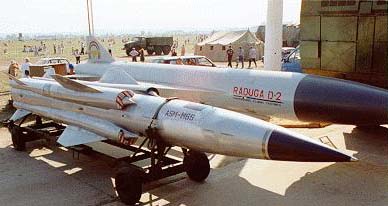I suspect that the Kh-32 was developed, but as the final fate of the Tu-22M3 was up in the air (ie will they upgrade or will they just scrap) that they probably didn't bother buying the new Kh-32, so the Kh-22M missiles seen on aircraft are actually Kh-22Ms, or perhaps dummys to represent a real payload.
Information on Kh-32 production ,like for any other critical and potentially "deciding" weapon in Russian arsenal,
are some of the most strictly controlled of the whole Russian military sector and all units produced of those critical up-to-date weapons are, obviously ,all stocked
and never shown on vehicles commonly employed for standard peace time operative tasks ; the motivation is that ,for a potential high-end enemy, against which those type of weapons would be used ,would be not only almost impossible to compute what carrying platforms and in what precise territorial position would be capable to employ them (in this way planning theirs missions and deployments accounting for the "area of risk" within theirs engagement footprint) but also render impossible to carry out pre-eventive saturating attacks on the underground sites where them are stocked .
About its mere development history it
Kh-32 is nothing of extraordinary or very surprising (....rather the contrary

.
Kh-22 was in Soviet times not only one of the most outstanding and devastating weapon in URSS's arsenal (one without any corresponding anywhere worldwide),
but ,unknown to most,
also one of the most important basis test-bed platforms employed by Soviets ,before, and Russians, after, for very very very advanced (and not merely theoretical..),
scientific works in Aerothermodynamics ,Physics and Engineering of materials ,Physics of Ionised Fields Variations and Disturbances, High Mach Aerodynamic Surfaces flow interaction etc..etc... The scientific
works on the Kh-22 test-bed passed through the Kh-22B ,experimental cruise missile (technically a success but impossible to mass produce for the excessive costs and the enormous difficulties in the making process) and of which the actual Kh-32 is a "son",
up to the scarcely known but outstanding Raduga D2 hypersonic test bed ,capable to sustain a speed in excess of Mach 6 up to 70 seconds in tests.
The Raduga-D2 was not simply a theoretically useful test-bed for scientific studies and empirical validations but a true complete cruise missile deprived of some components for research purposes and scaled-down for allow its export.
It was also exported, in a scaled down version ,in Europe -Germany- at beginning of '90 years (with a particular contract envisioning control and restrictions on the possibilities of share the information and some tests and modifications possible only in Russia by TsAGI and Raduga personnel) if has been practically, since then, the most used and debated hypersonic test bed in European scientific sector.
At page 24 of this OHB publication you can find some specific of the exported Raduga D2 and at the previous page a simplified design of the system.
http://ftp.rta.nato.int/public//PubFullText/RTO/EN%5CRTO-EN-AVT-185///EN-AVT-185-16.pdf
Only for realize the potential of the basis Kh-22 layout, is sufficient to say that
even only THIS export scientific test bed, (the not downgraded was available for test in Russia at beginning of 1989 !!)
had anticipated of over ten years the tests conducted by NASA with X-43A (with a
not fully independent hypersonic propulsion during only 10 seconds and
costing a full order of magnitude more ).
Moreover the difference in military value is even embarrassing ....
NASA X-43

Raduga-D2

I repeat
Kh-32's parameters can appear truly impressive on paper for foreign standard for weapons in its class ,
but for Russian operators in the field (
who have maked a loooong journey since achievements in the Raduga D2 years )
it represent ,in reality ,
simply an upgraded and mass produceable modern day Kh-22M capitalising "know how" acquired more than 20 years ago !!! 






